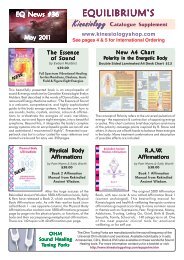You also want an ePaper? Increase the reach of your titles
YUMPU automatically turns print PDFs into web optimized ePapers that Google loves.
WT17 Glycogen<br />
The principal carbohydrate storage material in the body; plays an important role in controlling blood sugar<br />
levels.<br />
WT18 Glycogen Phosphorylase A<br />
Involved in converting glycogen to glucose.<br />
WT19 Glycogen Synthase<br />
Involved in converting glucose to glycogen.<br />
WT20 Growth Hormone Inhibiting Hormone / Somatostatin<br />
Inhibits secretion of insulin and glucagons and slows absorption of nutrients from the gastro-intestinal tract.<br />
WT21 Human Growth Hormone / Somatotropin<br />
Helps to maintain muscle and bone mass and promote healing of injuries and tissue repair; speeds up the<br />
breakdown of liver glycogen into glucose; excess production may cause diabetes mellitus.<br />
WT22 Insulin<br />
Decreases blood sugar levels.<br />
WT23 Leptin<br />
Released by fat cells as they synthesise triglycerides; reduces appetite; non-insulin dependent diabetes.<br />
WT24 Melanocyte-Stimulating Hormone / MSH<br />
Suppresses appetite.<br />
WT25 Neuromedin B<br />
Involved in blood glucose control; suppresses the appetite.<br />
WT26 Neuropeptide Y<br />
Stimulates appetite; causes increased storage of ingested food as fat; reduces energy expenditure.<br />
WT27 Orexin B<br />
Generated when blood sugar levels drop, so acting as a trigger to eat.<br />
WT28 Pheylalanine<br />
An amino acid. Precursor of tyrosine and therefore dopamine, norepinephrine (noradrenaline) and epinephrine<br />
(adrenaline), so affects blood sugar levels and fat metabolism; necessary for thyroid; involved in weight<br />
control.<br />
WT29 Prostaglandin E2 / PGE2<br />
Acts on adenylate cyclase to enhance the production of cyclic AMP.<br />
WT30 Protein Tyrosine Phosphatase / PTP1B<br />
Inhibits signaling of leptin and insulin1; may explain resistance to leptin and insulin; likely to be important in<br />
obesity and type 2 diabetes; drug research now being carried out to find drugs to inhibit PTP1B.<br />
WT31 Reverse T3 / 3,3’,5’-Triiodothyronine<br />
Reverse T3 and T3 are secreted in an inverse relationship allowing the thyroid to adjust the amount of thyroid<br />
activity; blocks the action of T3 by binding with the receptor sites.<br />
WT32 Serotonin<br />
Decreases carbohydrate cravings; provides a feeling of fullness; enhances mood.<br />
WT33 Thyroid-Stimulating Hormone / TSH<br />
Stimulates thyroid gland to produce its hormones.<br />
WT34 Thyrotropin Releasing Hormone / TRH<br />
Stimulates anterior pituitary to secrete TSH.<br />
WT35 Thyroxine / Tetraiodothyronine / T4<br />
Converted into T3; increase rate at which cells release energy from carbohydrates.<br />
WT36 Triiodothyronine/T3<br />
Regulates metabolism by stimulating carbohydrate and fat breakdown.<br />
WT37 Urocortin<br />
Inhibits appetite.<br />
WT38 Val-Pro-Asp-Pro-Arg<br />
Research on rats indicates that this is an appetite suppressant.<br />
Testing Kit Description Manual Copyright Jane Thurnell Read 2012 Page 155



